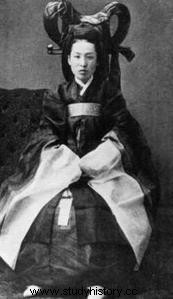Empress Myeongseong (1851 – 1895), also known as Queen Min, was the first official wife of King Gojong of Korea. Exercising the reality of power and opposing the expansionist policy of Japan, she died assassinated by her enemies.
Queen consort
 Daughter of Min Chi-Rock, of the aristocratic Min family, the future Empress Myeongseong was born on October 19, 1851 in Yeoju District in Korea. Little is known about her childhood except that she lost her parents at the age of eight.
Daughter of Min Chi-Rock, of the aristocratic Min family, the future Empress Myeongseong was born on October 19, 1851 in Yeoju District in Korea. Little is known about her childhood except that she lost her parents at the age of eight.
At the age of fifteen, Gojong's father, Daewongun, decides that his son must marry and looks for a bride for him among the noble families. Min Chi-Rock's daughter has all the necessary qualities:she is from an aristocratic family, she has a good level of education, good health and beautiful features. And after a strict selection process, she married the young king on March 20, 1866, becoming queen consort. They will have five children.
Political emancipation
As queen, she is expected to be an icon of high society, to organize social events with the royal family, but she refuses to do so. Instead, she reads books reserved for men and learns, on her own initiative, philosophy, history, science, politics and religion. People close to power describe her as an ambitious and assertive person. Quickly, she emancipated herself from Daewongun's domination, mounting a faction against him, playing a role in politics and countering the high officers. Forging alliances among high officers, scholars and members of her clan, she obtains that power returns to Gojong and that Daewongun is removed from it. There is no longer any doubt, then, that she reigns with her husband and that she plays a more active role than he does.
While Korea had closed itself to Japan, under pressure from the latter, a treaty was signed in 1876 to reopen the borders. From that moment, Queen Min sends emissaries to Japan to study its westernization and intentions. Upon their return, favorably impressed, she advocated modernizing Korea and opening up to the West, but she encountered resistance from the aristocracy, who feared that this openness would lead to the destruction of the social order. Despite these objections, Queen Min began to reorganize her government and sent soldiers to China for training in Western techniques.
Reversal attempts
Part of the army, furious at the preferential treatment reserved for new units and supported by Daewongun, tried to overthrow Gojong and his wife in 1882 but failed. In 1883, Queen Min sent a mission to the United States and the return of the emissaries increased her desire to modernize Korea. A school for the children of the elite opens at the palace, with foreign teachers who teach in English. Queen Min also opened the first school for girls and open to underprivileged children. It seeks to put an end to the persecutions against Christians and even invites missionaries. Under his reign, the first government newspaper appeared. It thoroughly modernized the army and its armament, but neglected the navy.
Throughout her reign, Queen Min forged alliances to counter Japan's influence and expansionist policy in Korea. On the morning of October 8, 1895, Japanese killers infiltrated the royal residence, fought the Korean guards, and assassinated Queen Min. Shocked, Gojong flees to Russia with the crown prince; it was not until 1897, when they returned to Korea, that a real funeral was organized. In 1902, she was given the posthumous name Hyoja Wonseong Jeonghwa Hapcheon Honggong Seongdeok Myeongseong Taehwanghu, often shortened to Myeongseong Hwanghu.
